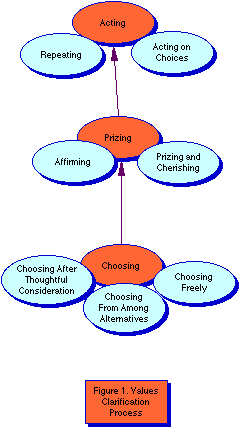![]()
![]()
• Chemical are harmful to humans.• Nuclear power plants should be banned.
• Fast foods are not nutritious and should be avoided.
• Smoking should be banned in public settings.
STS teaching creates an environment in which students are confronted with situations in which they must clarify their values on a variety of issues. The nature of today's value-laden issues and problems is contrary to the neutral or value-free connotation of science. How can students be helped to clarify their values about science issues?
The question that always arises in discussions of values teaching is what values should be taught, if they should be taught at all. In a class discussion of abortion, what is the role of the teacher, and whose value beliefs should guide the direction of a decision. Most educators would claim that a class activities of value-laden issues should involve a process of valuing as opposed to a particular value direction.
A process model of values clarification was developed by Raths, Harmin and Simon and is known as the values clarification approach. They define a value in terms of three key valuing processes: choosing, prizing and acting (Figure 1).

According to Raths, Harmin and Simon, the valuing process, whether the subject be abortion, drugs, birth control, health, population control, social responsibility of scientists, collectively involves seven criteria. In the spirit of science, Raths, Harmin and Simon claim that these criteria must emerge in a climate of free inquiry independent of authoritarian persuasion. Figure 6.6 outlines the major aspects of the valuing process as it relates to science teaching.
Key
Valuing Process Student
Actions Criteria Key
Teacher Questions Acting Repeating Acting on
Choices At this level, the
action will reappear a number of times. Demonstrating
choices by integrating the choice in our life. • How did you
decide which had priority? • How has it
already affected your life? Prizing Affirming Prizing and
Cherishing Willing to affirm
the choice publicly. The individual
esteems, respects and hold the value dear. • Would you
explain to others how you feel about this? • Are you glad
you feel that way? Choosing After thoughtful
consideration Choosing from
alternatives Choosing
freely Reflective thought
based on research and investigation. Examining
alternatives and then making a choice. Choosing without
coercion. • What is the
basis for your choice? • What ideas
did you reject before making this choice? • Where did the
idea for your choice come from?
One of the keys to implementing values clarification in the science classroom is the utilization of methods that enable students to choose, prize and act on STS issues. Five methods are presented that are designed to help students develop clearer values about STS issues. These include the value dilemma sheet, STS action dramas, action voting, case studies and STS action projects.